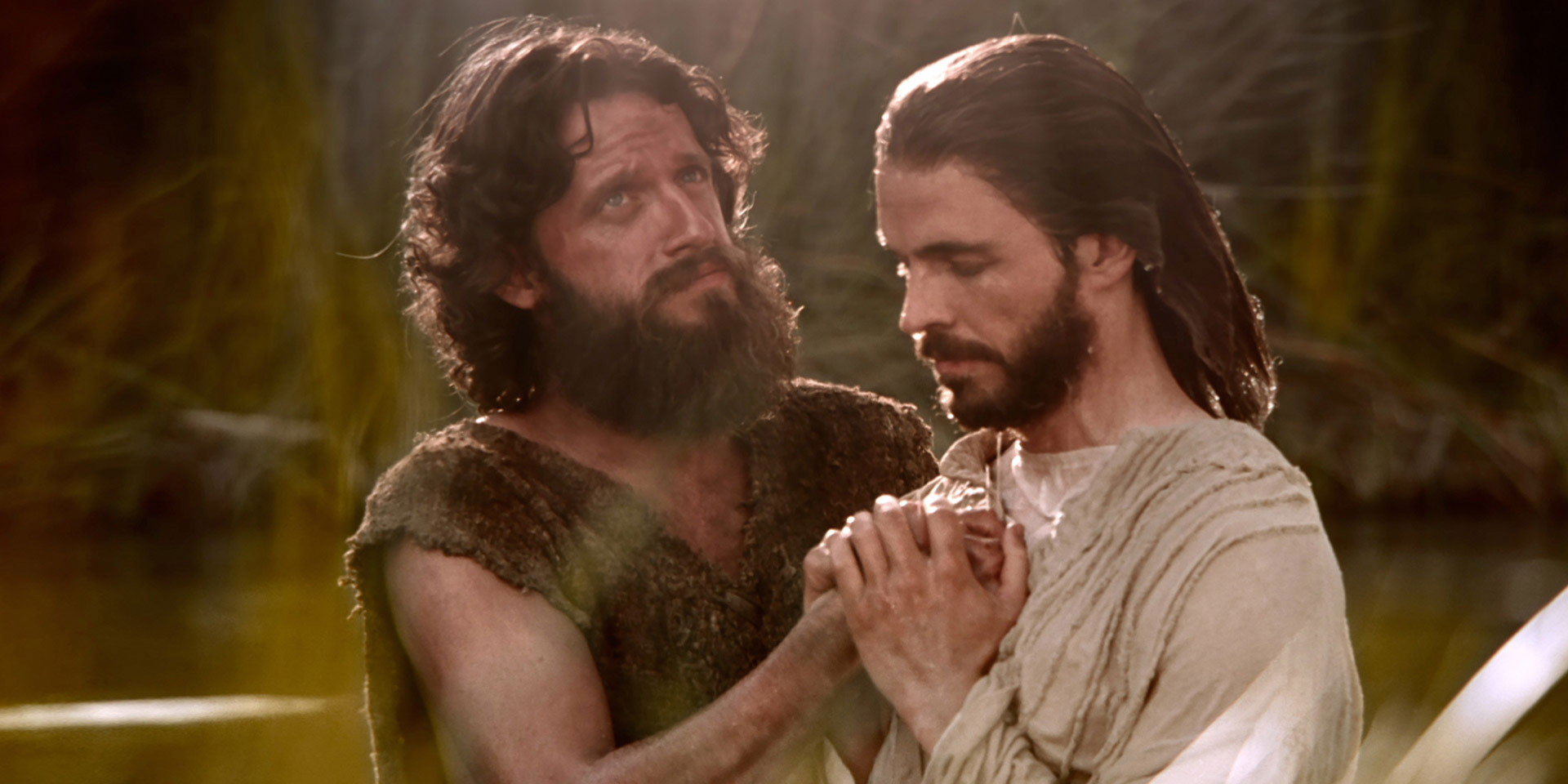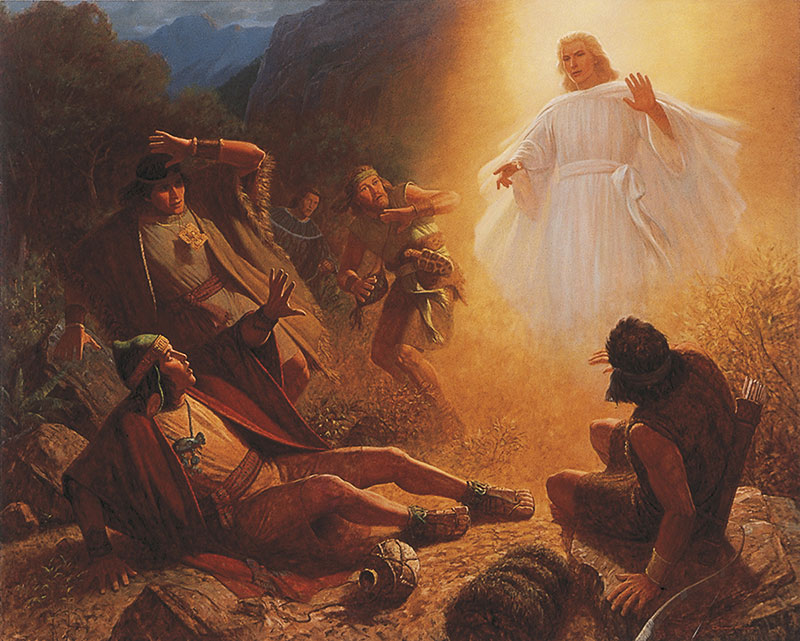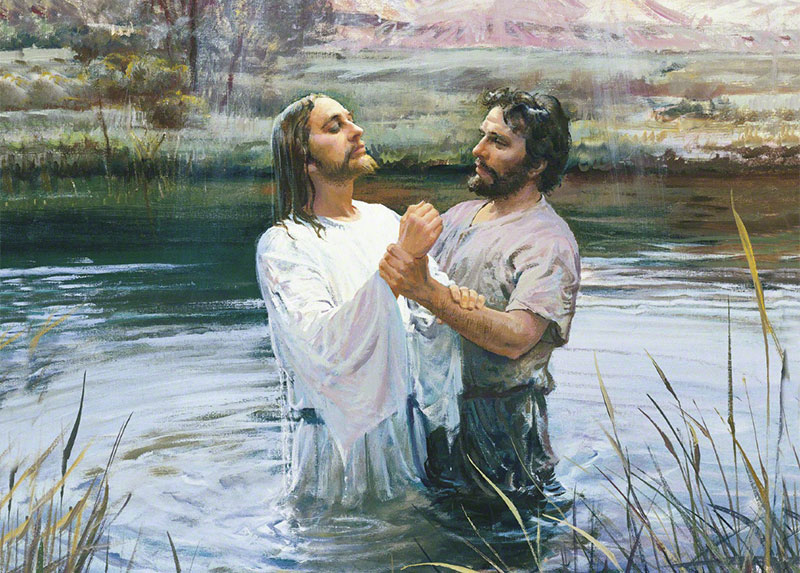Ye Must Be Born Again Lds
You are here

February vii, 2019
KnoWhy #501

Still Image from "The Baptism of Jesus" via LDS Media Library
"And the Lord said unto me: Marvel not that all flesh, yea, men and women, all nations, kindreds, tongues and people, must be born again; yea, built-in of God, inverse from their carnal and fallen country, to a state of righteousness, being redeemed of God, condign his sons and daughters."
Mosiah 27:25
The Know
The need for Christ's followers to exist "born once more," as famously described in John 3:3, is one of the most well-known New Attestation doctrines.1 It captures mankind's universal need for spiritual transformation and offers hope that such transformation tin come up to all who seek it. Nevertheless this doctrine has also get a matter of debate and controversy among some Christian believers. Thankfully, the Volume of Mormon discusses being "born again" or "built-in of God" on a number of occasions. These relevant passages, when correlated with other scriptures and Latter-day revelations, offer vividly engaging examples and spiritually impressive explanations that clarify and deepen whatever reader'southward understanding of what it means to be "born once more."2
Ane fascinating example comes from the story of Alma the Younger. After existence rebuked by an angel, Alma brutal into a weak and helpless condition where he could no longer speak and his limbs lost their forcefulness. When Alma awoke from this state, he declared,
I have repented of my sins, and have been redeemed of the Lord; behold I am born of the Spirit. And the Lord said unto me: Marvel not that all mankind, yea, men and women, all nations, kindreds, tongues and people, must be born once again; yea, born of God, changed from their carnal and fallen country, to a state of righteousness, being redeemed of God, becoming his sons and daughters; And thus they become new creatures; and unless they practice this, they can in nowise inherit the kingdom of God. (Mosiah 27:24–26)3

Conversion of Alma the Younger by Gary L. Kapp. Prototype via LDS Media Library.
Alma's language hearkens back to King Benjamin's famous speech communication where he declared to his people,
And now, because of the covenant which ye have made ye shall exist called the children of Christ, his sons, and his daughters; for behold, this day he hath spiritually begotten you; for ye say that your hearts are changed through religion on his name; therefore, ye are born of him and have get his sons and his daughters. … I would that ye should take upon you lot the proper name of Christ, all y'all that accept entered into the covenant with God that ye should exist obedient unto the finish of your lives. (Mosiah 5:vii–eight)4
Finally, when Alma was preaching to the people of Zarahemla, he asked them a number pointed questions apropos spiritual rebirth. Alma's own harrowing experience with beingness spiritually reborn makes these questions specially insightful:
And at present behold, I ask of you, my brethren of the church, take ye spiritually been born of God? Take ye received his image in your countenances? Have ye experienced this mighty change in your hearts? Exercise ye exercise faith in the redemption of him who created you? … I say unto y'all, can ye look up to God at that solar day with a pure heart and clean hands? (Alma 5:14–15, xix)5
Amongst the many of import points that can be taken from these Volume of Mormon passages are the post-obit:
- Being built-in once again is universally required of all of God's children (Mosiah 27:25; cf. Alma five:49).
- Beingness born again is needed to inherit the Kingdom of God (Mosiah 27:26; cf. Alma 5:51).
- Existence built-in again signifies "faith in the redemption of him who created y'all" (Alma 5:xv).
- Being built-in again signifies that sincere repentance has taken place (Mosiah 27:24; cf. Alma 5:49–51).
- Those who are built-in again enter into a covenant with God to "be obedient unto the end of [their] lives" (Mosiah 5:8).
- Those who are built-in over again accept upon themselves the "name of Christ" (Mosiah 5:8).
- Those who are born again get the "children of Christ, his sons, and his daughters," and are "spiritually begotten" of Him (Mosiah five:7).vi
- The hearts of those who are born again are "inverse through organized religion on [Christ'south] name" (Mosiah 5:vii; Alma 5:12–14).
- Those who are built-in again receive Christ's "image in [their] countenances" (Alma 5:xiv).vii
- Those who are born again have "a pure middle and clean hands" (Alma 5:19).

John Baptizing Jesus by Harry Anderson. Image via LDS Media Library.
The Why
While the above passages don't represent all that the Volume of Mormon has to say about beingness born over again, they give a good representation of its teachings on the subject. What should be articulate is that, rather than being a singular event or occurrence, existence born again is a process of spiritual rebirth and refinement.viii It begins with a sacred covenant or commitment to alter our lives, which is formally entered into at baptism,9 and and so it requires lasting religion, repentance, and spiritual purity on our part—in both actions and intent.x In order to facilitate the process of spiritual refinement, the gift of the Holy Ghost is conferred (by the laying on of easily) upon all those who are baptized (see Moroni 2; 3 Nephi nineteen:xx–22).
In response to our sincere and persistent efforts to exercise faith and repent, our hearts will be spiritually transformed through the power of Christ and then that "we have no more disposition to practice evil, simply to do proficient continually" (Mosiah five:2). As S. Michael Wilcox has noted, "Whenever the Volume of Mormon speaks of being born again, the heart is the center of the altered state."11 This internal transformation then acts as a precursor to a more eternal and permanent external transformation of our physical bodies, which will be facilitated through the power of Christ's resurrection.12
This dual process of transformation, outset spiritual and and so concrete,13 is aptly represented by the ordinance of baptism, which in diverse means symbolizes nascency, decease, and resurrection.fourteen While baptism is indeed an outcome, the process of spiritual rebirth which it symbolically initiates is a lifelong endeavor.xv Although individuals may sometimes feel dramatic and rapid spiritual transformations, like the Apostle Paul and Alma the Younger did, they withal must "be obedient unto the end of [their] lives" (Mosiah 5:8). Otherwise, the positive spiritual transformation which they experienced volition be reversed. Every bit Mormon warned, they will "get more hardened, and thus their state becomes worse than though they had never known [or experienced] these things" (Alma 24:thirty).16

Boy Existence Baptized via LDS Media Library.
With these principles in mind, readers may wonder where they stand personally in this process of spiritual rebirth. Elder Bruce R. McConkie taught that the reply can be found in the Book of Mormon:
Read the fifth chapter of Alma for the recitation of the tests that tell a person whether he has been built-in once more and how he knows. You know if you have been built-in once more, or you know the degree to which you lot take been born again; it is the measure to which you proceed the commandments and feed the Lord's sheep and strengthen your brethren. In other words, it is the measure of your involvement in the things of the Spirit, in the things of the Church building.17
While what we do outwardly is certainly important, the Book of Mormon demonstrates that what we go inwardly is of fifty-fifty greater significance.eighteen Eventually, as we truly come up unto Christ, the in transformation that we so desire will be permanently "engraven" upon us (Alma five:19). Nosotros will "become new creatures" in Christ (Mosiah 27:26), who volition "seal [united states] his" through the infinite power of His Amende and resurrection (Mosiah 5:15). Improve than any other volume of scripture, the Book of Mormon outlines this procedure of deep spiritual transformation, providing readers a clear path toward eternal life.
This KnoWhy was fabricated possible by the generous support of The Welch Family unit Trust.
Farther Reading
D. Todd Christofferson, "Born Again," Ensign, May 2008, online at lds.org.
Jerome Chiliad. Perkins, "Alma the Younger: A Disciple's Quest to Become," in Living the Book of Mormon: Abiding by Its Precepts, ed. Gaye Strathearn and Charles Swift (Provo, UT: Religious Studies Center, Brigham Young University, 2007), 151–162.
Brent 50. Tiptop, "Spiritual Rebirth: Take Ye Been Built-in of God?" in The Book of Mormon and the Bulletin of The Four Gospels, ed. Ray L. Huntington and Terry B. Brawl (Provo, UT: Religious Studies Center, Brigham Young University, 2001), 201–217.
James Due east. Faust, "Built-in Once again," Ensign, May 2001, online at lds.org.
South. Michael Wilcox, "Spiritual Rebirth," in Mosiah, Salvation Merely Through Christ, Book of Mormon Symposium Series, Volume 5, ed. Monte S. Nyman and Charles D. Tate, Jr. (Provo, UT: Religious Studies Center, Brigham Young University, 1991), 247–260.
- 1. For other New Testament references to being "born again" or "born of God," run across 1 Peter i:23; one John iii:nine–10; ane John 4:7; one John five:1, 4.
- 2. For a general treatment of this topic, meet Ed J. Pinegar, "Born of God," Encyclopedia of Mormonism, ed. Daniel H. Ludlow (New York, NY: Macmillan, 1992), 1:218–219.
- iii. For further analysis of Alma's conversion, see Book of Mormon Fundamental, "Why Was Alma Converted? (Alma 36:21)," KnoWhy 144 (July 15, 2016); S. Kent Brown, "Alma'due south Conversion: Reminiscences in His Sermons," in Alma, The Testimony of the Word, Book of Mormon Symposium Series, Volume six, ed. Monte S. Nyman and Charles D. Tate Jr. (Provo, UT: Religious Studies Centre, Brigham Immature University, 1992), 141–156; reprinted in Southward. Kent Brown,From Jerusalem to Zarahemla: Literary and Historical Studies of the Book of Mormon (Provo, UT: Religious Studies Center, Brigham Young University, 1998), 113–127; John W. Welch, "Iii Accounts of Alma's Conversion," inReexploring the Book of Mormon: A Decade of New Inquiry, ed. John W. Welch (Table salt Lake City and Provo, UT: Deseret Book and FARMS, 1992), 150–153; John W. Welch and J. Gregory Welch,Charting the Book of Mormon: Visual Aids for Personal Study and Teaching (Provo, UT: FARMS, 199), charts 106–107; Jerome Yard. Perkins, "Alma the Younger: A Disciple's Quest to Become," in Living the Book of Mormon: Abiding past Its Precepts, ed. Gaye Strathearn and Charles Swift (Provo, UT: Religious Studies Centre, Brigham Young University, 2007), 151–162.
- 4. Run across Volume of Mormon Central, "Why Did Rex Benjamin Say That His People Would be Sons and Daughters at God'southward Right Hand? (Mosiah 5:seven)," KnoWhy 307 (May 1, 2017); Matthew L. Bowen, "Becoming Sons and Daughters at God's Right Hand: King Benjamin's Rhetorical Wordplay on His Ain Name,"Journal of the Book of Mormon and Other Restoration Scripture 21, no. two (2012): ii–13; Robert L. Millet, "The Ministry of the Father and the Son," in The Volume of Mormon: The Keystone Scripture, ed. Paul R. Cheesman, S. Kent Brown, and Charles D. Tate, Jr. (Provo, UT: Religious Studies Center, Brigham Young University, 1988), 57–60.
- 5. Meet Book of Mormon Central, "Why Did Alma Inquire Church Members Fifty Probing Questions? (Alma 5:fourteen–15)," KnoWhy 112 (June one, 2016).
- 6. Conversely, those who remain in their sins and never undergo spiritual rebirth are the "the children of the kingdom of the devil" (Alma five:25; cf. Mosiah 5:x).
- vii. Encounter Book of Mormon Central, "Why Did Alma Ask most Having God'due south Image Engraven upon 1'south Countenance? (Alma 5:19)," KnoWhy 295 (April 3, 2017).
- 8. For commentary on the various Christian misunderstandings of the process of spiritual rebirth, see Robert L. Millet, "Joseph Smith Encounters Calvinism," BYU Studies Quarterly fifty, no. iv (2011): 23–24: "When men and women sincerely nail their sins to the cross of Christ, their identity is changed and their nature is transformed. And yet, every bit major Christian writers have pointed out recently, too many professing Christians have walked an aisle, signed a carte, prayed a prayer, and withal not forsaken worldliness. They talk the talk but do not walk the walk: they do not live essentially whatever differently than people of the world. And why is this? The consensus among many of these contempo Christian writers is that so much emphasis has been placed upon salvation as a free gift, upon the grace of Deity and the alert against legalistic obedience, that too lilliputian emphasis has been placed upon the discipleship associated with the Savior's invitation: 'If any man will come up subsequently me, permit him deny himself, and accept upward his cross daily, and follow me' (Luke 9:23), or: 'If ye love me, keep my commandments' (John 14:fifteen). Salvation has been teased apart from discipleship. Conversion and rebirth have been separated from obedience. An unintended but inappropriate wall has been constructed between justification and sanctification."
- 9. Brent L. Top has described baptism as the "Gateway to Spiritual Rebirth." Brent L. Top, "Spiritual Rebirth: Have Ye Been Born of God?" in The Book of Mormon and the Message of The Four Gospels, ed. Ray L. Huntington and Terry B. Ball (Provo, UT: Religious Studies Center, Brigham Young University, 2001), 202.
- ten. Encounter Elderberry D. Todd Christofferson, "Born Over again," Ensign, May 2008, online at lds.org: "You may ask, 'Why doesn't this mighty modify happen more rapidly with me?' Yous should call back that the remarkable examples of Male monarch Benjamin's people, Alma, and some others in scripture are just that—remarkable and not typical. For almost of u.s.a., the changes are more gradual and occur over time. Being built-in again, unlike our concrete nascence, is more than a process than an event. And engaging in that process is the primal purpose of mortality."
- eleven. Come across S. Michael Wilcox, "Spiritual Rebirth," in Mosiah, Conservancy Just Through Christ, Book of Mormon Symposium Series, Book 5, ed. Monte S. Nyman and Charles D. Tate, Jr. (Provo, UT: Religious Studies Heart, Brigham Young University, 1991), 251.
- 12. Meet 3 Nephi 28:38; Doctrine and Covenants 76:70.
- thirteen. In a passage which explains this duality in all of God's creations, the Lord declared "as the words have gone along out of my rima oris fifty-fifty then shall they be fulfilled, that the first shall be last, and that the concluding shall exist starting time in all things whatever I accept created past the discussion of my power, which is the power of my Spirit" (Doctrine and Covenants 29:30).
- 14. Encounter Noel B. Reynolds, "Understanding Christian Baptism through the Book of Mormon," BYU Studies Quarterly 51, no. 2 (2012): three–37.
- fifteen. See Joseph Fielding McConkie and Robert 50. Millet, Doctrinal Commentary on the Book of Mormon, Book Ii: Jacob through Mosiah (Salt Lake City, UT: Bookcraft, 1988), 174.
- xvi. Meet also, Doctrine and Covenants twenty:32).
- 17. Bruce R. McConkie, "Be Ye Converted," address given at the BYU First Stake Quarterly Conference (11 February 1968), as cited in Larry E. Dahl, "The Doctrine of Christ: 2 Nephi 31–32," in Second Nephi, The Doctrinal Structure, Book of Mormon Symposium Serial, Book three, ed. Monte S. Nyman and Charles D. Tate, Jr. (Provo, UT: Religious Studies Middle, Brigham Young Academy, 1989), 367.
- 18. For instance, Volume of Mormon prophets repeatedly recognized that becoming inwardly "alive in Christ" held greater value than merely complying with outward performances and ordinances (see 2 Nephi 25:25; cf. Mosiah 13:27–32).
KnoWhy Citation
Related KnoWhys
Subscribe
Get the latest updates on Book of Mormon Central and other projects.
DONATE
Source: https://knowhy.bookofmormoncentral.org/knowhy/what-does-it-mean-to-be-born-again

0 Response to "Ye Must Be Born Again Lds"
Post a Comment